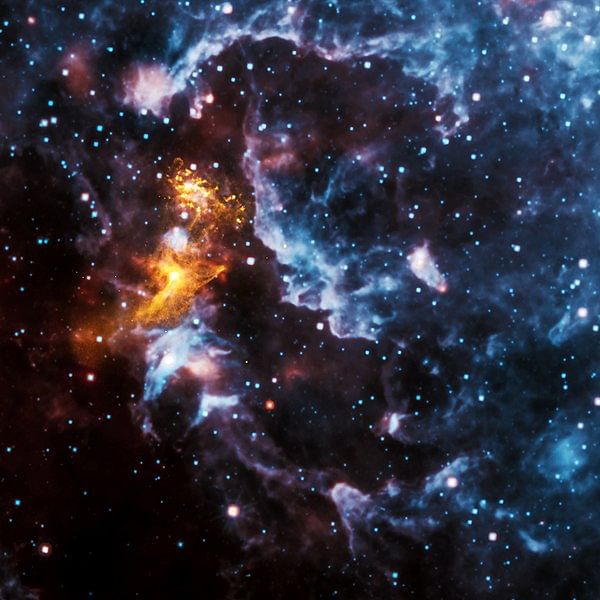
A neutron star is an astronomical object composed almost entirely of neutrons, making it super-dense. Gravity from its dense matter makes that stellar matter from another star, often like the Sun, fall onto its surface, forming a disk around it. Hence, it is the natural laboratory of extreme conditions impossible to create in any laboratory on Earth. Sometimes, a neutron star emits sudden bursts of X-ray photons that astronomers use to study its interiors, its surface and its environment.
A study by a team of astronomers at the Indian Institute of Technology Indore (IIT-Indore), using data from ISRO’s AstroSat, has revealed deviations from what astrophysicists knew of neutron stars from the bursts. AstroSat hosts five telescopes observing the same astrophysical source at the same time. The astronomers used AstroSat’s two instruments, the Soft X-ray Telescope (SXT) and the Large Area X-ray Proportional Counter (LAXPC), to simultaneously catch bursts from a neutron star.
The neutron star that the team studied is one of the most well-studied neutron stars, said Chandreyee Maitra, Max Planck Institute for Extraterrestrial Physics, Garching, Germany. Chandreyee was not involved in the current study.
This particular neutron star emits bursts at a rate of about one every four hours, making it the go-to astronomical laboratory of extreme physics.
Astronomers are interested to know how the number of X-ray photons varies with their wavelengths, which they call the ‘spectrum’. The X-ray spectrum of a neutron star holds important clues to the physical processes at play in the neutron star’s surface and immediate environment.
Blackbodies
Blackbody radiation is a standard form of electromagnetic radiation by a source whose components have reached a state of equilibrium. Contrary to what its name suggests, a blackbody emits light of all wavelengths. For example, our Sun is an example of a blackbody, and its spectrum peaks at the visible wavelengths.
Earlier, astronomers have studied the spectra of neutron star sources with NASA’s X-ray missions like the Rossi X-ray Timing Explorer (RXTE), Neutron Star Interior Composition Explorer (NICER), Nuclear Spectroscopic Telescope Array (NuSTAR) and the ESA’s X-ray Multi-Mirror Mission (XMM-Newton). They have found that the spectra during the bursts closely resemble the blackbody spectrum, peaking at wavelengths where each photon is more than 1,000 times energetic than visible light’s photons. Estimating this wavelength allows astrophysicists to calculate the temperature of the neutron stars’ surface.
Earlier studies had also hinted that sometimes, the spectrum deviates from the blackbody function. Astrophysicists speculate that the deviations result from the interaction of the neutron star’s radiation with its immediate environment, consisting of matter falling onto its surface from its companion star. The hot matter itself emits X-ray photons and changes the photons from the neutron star in complicated ways. The astrophysicists involved in the AstroSat study makes a strong case that such processes are at play in the neutron star they studied. “The study comes to this conclusion over many bursts, including the fainter ones,” agreed Chandreyee.
By studying the spectra of 15 bursts that the SXT and LAXPC detected simultaneously, the astrophysicists estimated a quantity measuring the deviation from the blackbody spectrum. By studying how this quantity evolved, they quantified how the mass inflow from the companion star to the neutron star changed during the burst.
Scientists refer to simultaneous studies of a source at different wavelengths as broadband studies. Chandreyee informed that earlier broadband studies of bursts required astronomers to use different X-ray detectors, introducing errors that make studying the spectrum difficult. AstroSat lets the astronomers study the same burst with different detectors on the same satellite, reducing the errors.
The researchers of the present study used the broadband AstroSat data to investigate different mathematical models of how the neutron star, the burst radiation, and the environment interact. However, all the alternative spectral models fit the data. That is, the researchers could not offer any definite conclusion about which mathematical model is better. “However, it’s a nice starting point, which motivates more such studies,” Chandreyee said.
Unnati Kashyap, a PhD scholar at IIT-Indore and the study’s primary author, explained that astronomers would like to distinguish between photons emitted by matter falling onto the neutron star with photons emitted by matter permanently clouding the star. Only a finer resolution of the neutron star spectra could help them do so.
Chandreyee feels that astronomers should look at the archives of all X-ray instruments, as simultaneous data of the same bursts may exist in the archives of NuSTAR, XMM-Newton, NICER, and AstroSat.
Unnati clarified that the team at IIT-Indore has searched the data archives of AstroSat post 2017. The observations reported in the study are the only ones where the team could see bursts simultaneously in SXT and LAXPC in this period. In some cases, only one of the two instruments would have detected a burst, rendering a broadband study impossible. However, she agreed that the team has not gone over the archives of NuSTAR and XMM-Newton themselves. “When we looked for simultaneous data for NICER and AstroSat, we could not find any.”
Chandreyee suggested that if astronomers do not find more data by digging further through the archives, they could plan dedicated campaigns with these instruments. Unnati reveals that the IIT-Indore team plans to schedule simultaneous observations of the source with AstroSat and NICER. “NICER and AstroSat-LAXPC can together make it possible to probe the origin of the deviations from the standard blackbody spectrum,” she signed off.